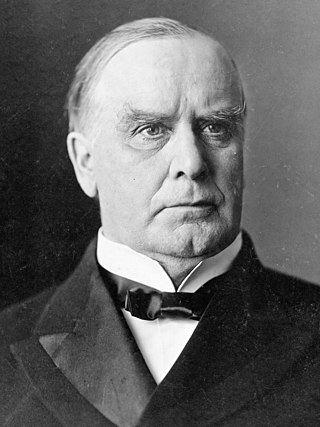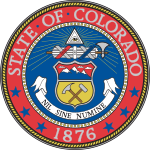
The 1896 United States presidential election was the 28th quadrennial presidential election, held on Tuesday, November 3, 1896. Former Governor William McKinley, the Republican nominee, defeated former Representative William Jennings Bryan, the Democratic nominee. The 1896 campaign, which took place during an economic depression known as the Panic of 1893, was a political realignment that ended the old Third Party System and began the Fourth Party System.

The 1900 United States presidential election was the 29th quadrennial presidential election, held on Tuesday, November 6, 1900. In a re-match of the 1896 race, incumbent Republican President William McKinley defeated his Democratic challenger, William Jennings Bryan. McKinley's victory made him the first president to win a consecutive re-election since Ulysses S. Grant accomplished the same feat in 1872. Until 1956, this would be the last time in which an incumbent Republican president would win re-election after serving a full term in office. This election saw the fifth rematch in presidential history, something that would also not occur again until 1956. This was also the first rematch to produce the same winner both times.

William Jennings Bryan was an American lawyer, orator, and politician. Beginning in 1896, he emerged as a dominant force in the Democratic Party, running three times as the party's nominee for President of the United States in the 1896, 1900, and 1908 elections. He served in the House of Representatives from 1891 to 1895 and as the Secretary of State under Woodrow Wilson from 1913 to 1915. Because of his faith in the wisdom of the common people, Bryan was often called "the Great Commoner", and because of his rhetorical power and early fame as the youngest presidential candidate, "the Boy Orator".

The People's Party, also known as the Populist Party or simply the Populists, was a left-wing agrarian populist political party in the United States in the late 19th century. The Populist Party emerged in the early 1890s as an important force in the Southern and Western United States, but collapsed after it nominated Democrat William Jennings Bryan in the 1896 United States presidential election. A rump faction of the party continued to operate into the first decade of the 20th century, but never matched the popularity of the party in the early 1890s.

The 1896 United States presidential election in Montana took place on November 3, 1896, as part of the 1896 United States presidential election. Voters chose three representatives, or electors to the Electoral College, who voted for president and vice president.

The 1896 United States presidential election in New York took place on November 3, 1896. All contemporary 45 states were part of the 1896 United States presidential election. Voters chose 36 electors to the Electoral College, which selected the president and vice president.

The 1896 United States elections elected the 55th United States Congress. Republicans won control of the presidency and maintained control of both houses of Congress. The election marked the end of the Third Party System and the start of the Fourth Party System, as Republicans would generally dominate politics until the 1930 elections. Political scientists such as V.O. Key, Jr. argue that this election was a realigning election, while James Reichley argues against this idea on the basis that the Republican victory in this election merely continued the party's post-Civil War dominance. The election took place in the aftermath of the Panic of 1893, and featured a fierce debate between advocates of bimetallism and supporters of the gold standard.

The 1900 United States presidential election in Virginia took place on November 6, 1900, as part of the 1900 United States presidential election. Voters chose 12 representatives, or electors to the Electoral College, who voted for president and vice president.

The 1900 United States presidential election in Wisconsin was held on November 6, 1900 as part of the 1900 United States presidential election. State voters chose 12 electors to the Electoral College, who voted for president and vice president.

The 1896 United States presidential election in Utah was held on November 3, 1896 as part of the 1896 United States presidential election. Voters chose three representatives, or electors to the Electoral College, who voted for president and vice president. This was the first time Utah participated in a presidential election, having been admitted as the 45th state on January 4 of that year.

The 1900 United States presidential election in Georgia took place on November 6, 1900, as part of the wider United States presidential election. Voters chose 13 representatives, or electors, to the Electoral College, who voted for president and vice president.

The 1896 United States presidential election in Georgia took place on November 3, 1896, as part of the wider United States presidential election. Voters chose 13 representatives, or electors, to the Electoral College, who voted for president and vice president.

The 1896 United States presidential election in Idaho took place on November 3, 1896. All contemporary 45 states were part of the 1896 United States presidential election. State voters chose three electors to the Electoral College, which selected the president and vice president.

The 1896 United States presidential election in Colorado took place on November 3, 1896. All contemporary 45 states were part of the 1896 United States presidential election. Voters chose four electors to the Electoral College, which selected the president and vice president.

The 1896 United States presidential election in Michigan took place on November 3, 1896. All contemporary 45 states were part of the 1896 United States presidential election. Voters chose 14 electors to the Electoral College, which selected the president and vice president.

The 1896 United States presidential election in Kentucky took place on November 3, 1896. All contemporary 45 states were part of the 1896 United States presidential election. Voters chose 13 electors to the Electoral College, which selected the president and vice president.

The 1896 United States presidential election in North Dakota took place on November 3, 1896. All contemporary 45 states were part of the 1896 United States presidential election. Voters chose three electors to the Electoral College, which selected the president and vice president.

The 1900 United States presidential election in Kentucky took place on November 6, 1900. All contemporary 45 states were part of the 1900 United States presidential election. Voters chose 13 electors to the Electoral College, which selected the president and vice president.

The 1900 United States presidential election in North Carolina took place on November 6, 1900. All contemporary 45 states were part of the 1900 United States presidential election. Voters chose 11 electors to the Electoral College, which selected the president and vice president.

The 1900 United States presidential election in Washington took place on November 6, 1900. All contemporary 45 states were part of the 1900 United States presidential election. State voters chose four electors to the Electoral College, which selected the president and vice president.






















